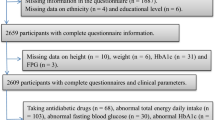Abstract
The serum and urine chromium concentrations of 57 diabetics and 55 normal fasting subjects were determined by atomic absorption spectrometry (AAS). Our results indicate that the chromium concentration ranges of serum and urine for diabetics are 0.22–0.36 and 4.54–5.90 μg/L, respectively, significantly lower than 0.66–0.84 7.80–9.68 μg/L for the normal (P<0.001), which implies that the elderly diabetics probably lack chromium. Further, it was found that the urine chromium level of the female diabetics was substantially higher than that of the male in the same age group (P<0.01), whereas the serum chromium level was almost the same. However, the urine chromium concentration increases with aging, no matter who the diabetics or the controls are. The serum chromium concentrations of the 24 cases patients with 2-h oral glucose tolerance test (OGTT) were significantly lower than that of those with empty stomach, whereas the urine chromium exhibits a contrary tendency. Our data indicate that the chromium lost and excreted from human body increases with aging and is related to the diabetics. Thus, it is recommended to supplement a certain amount of chromium to the elderly diabetics according to their nutritional level.
Similar content being viewed by others
References
M. Simonoff, D. Shapcott, S. Alameddine, et al., The isolation of glucose tolerance factor from brewer’s yeast and their relation to chromium,Biol. Trace Elem. Res. 32, 26 (1992).
R. T. Mossop, Effects of chromium (III) on fasting glucose, cholesterol and cholesterol HDL levels in diabetics,Cent. Afr. J. Med. 29, 80–82 (1981).
W. Mertz, E. W. Toepfer, E. E. Roginski, et al., Present knowledge of the role of chromium,Fed. Proc. 33, 2275 (1974).
Z. Y. Dai,Practical Medicine, vol. 2, Beijing, (in Chinese), p. 102 (1986).
S. Solomong, Trace elements in nutrition of the elder,Postgrad. Med. 79, 251 (1986).
R. A. Anderson, Chromium. In: W. Mertz,Trace Elements in Human and Animal Nutrition, vol. 1, 5th ed., London, Academic Press, p. 225 (1987).
Shi Ping, Liu Junyi, Wei Yinlin, et al., Determination of normal value of urine chromium in Langfang,Chin. J. Prev. Med. (in Chinese)25(60), 377 (1991).
E. G. Offenbacher, chromium in the elderly,Biol. Trace Elem. Res. 32, 123 (1992).
WHO study group, Diabetes mellitus,WHO Tech. Rep. Ser. 727, Geneva: WHO (1980).
National Research Council,Recommend Dietary Allowances, National Academy of Sciences, Washington D.C. (1980).
Author information
Authors and Affiliations
Rights and permissions
About this article
Cite this article
Ding, W., Chai, Z., Duan, P. et al. Serum and urine chromium concentrations in elderly diabetics. Biol Trace Elem Res 63, 231–237 (1998). https://doi.org/10.1007/BF02778941
Received:
Accepted:
Issue Date:
DOI: https://doi.org/10.1007/BF02778941




